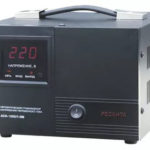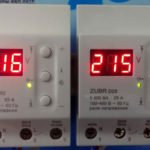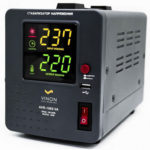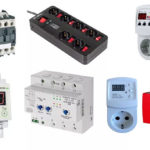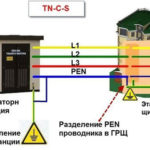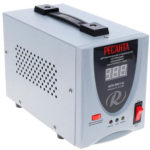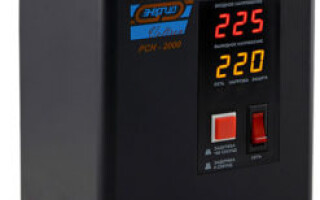Now the problem with low voltage in the network is gaining momentum. It is possible to solve it with a voltage stabilizer, which will protect all the equipment from breakdowns. In order to determine the choice of equipment, you need to learn about their varieties, the principles of each, as well as their advantages and disadvantages.
Contents
Main types and types of voltage regulators
Relay
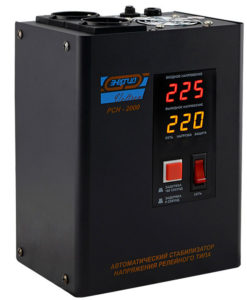
The second name of devices - stepped. This type is the most purchased for home and cottage use. This can be explained by the low price of the stabilizer and its high regulation accuracy. Relay stabilizers work on the following principle: the transformer switch windings with a power relay, which is triggered automatically. A sensor monitors the state of the network. If the voltage is out of tolerance, the relays adjust it. Adjustment takes place by switching the windings from one to the other, the voltage of which is as close as possible to the first.
Relay stabilizers are designed to protect the following devices:
- household appliances;
- Lighting fixtures (except LED);
- Laboratory and medical equipment;
- navigation systems;
- charging systems;
- computer and communications networks.
Advantages of relay transformers:
- compactness;
- a wide range of input current parameters and operating temperature (can operate within the range of -40 to +40 degrees);
- low price;
- long service life (capable of working up to 10 years).
Let us note the disadvantages of relay transformers:
- the nature of switching is stepwise;
- In comparison with other types of stabilizers poor ability to load relay contacts;
- high acoustic noise;
- The load current sinusoidal waveform at high input voltage is highly distorted - this is due to the magnetic saturation of the core.
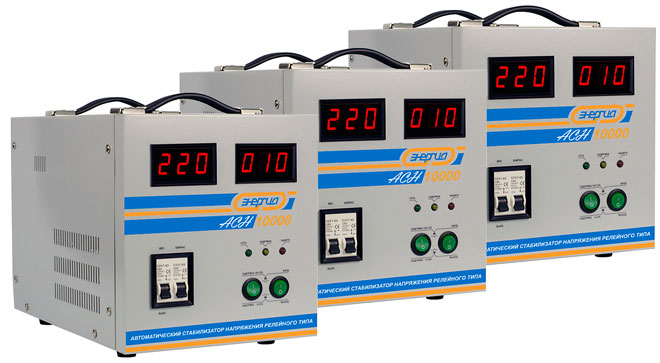
Electronic - triac and thyristor relays
The structure of these devices is similar to electromagnetic relays. But in this case, semiconductor products are used for step switching of autotransformer windings. There are several types of such electronic circuits, each of which is responsible for automatic switching of the transformation ratio. Devices are now produced in which triacs and thyristors are responsible for step switching.
A thyristor is a semiconductor system in which there is deep positive feedback. It provides fast switching during key operation.
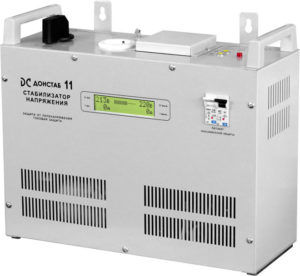
A triac is two combined thyristors with control electrodes. They are connected in a counter-parallel system. Thyristor type transformers are characterized by high efficiency, this is due to the possibility of current flow in two directions.
However, thyristor type devices are purchased more often, because they are made according to a simplified scheme. This means that it will be easier to maintain such a stabilizer.
Electronic transformers are used to protect the following devices:
- video and audio equipment;
- Air conditioning and refrigeration equipment;
- computers and their components;
- kitchen appliances;
- washing machines;
- floor heating system.
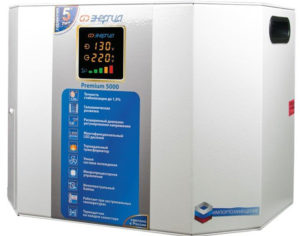
Main advantages:
- high stabilization factor;
- fast adjustment of drops;
- convenient parameters;
- high reliability indicators;
- low power consumption;
- protection against external interference;
- operation at indoor temperatures down to -40 degrees.
Disadvantages of electronic stabilizers:
- high price;
- high repair costs;
- not suitable for working with reactive loads.
Servo-driven (electromechanical)
Electromechanical transformers solve one of the major problems with devices with mechanical relays, which can only provide a stepped type of output voltage regulation. Mechanism of operation of servo stabilizers is to change the ratio of transformation. This is due to the brush, which is connected to the electrode of the output terminals. An additional electric motor helps the brush move along the secondary winding.
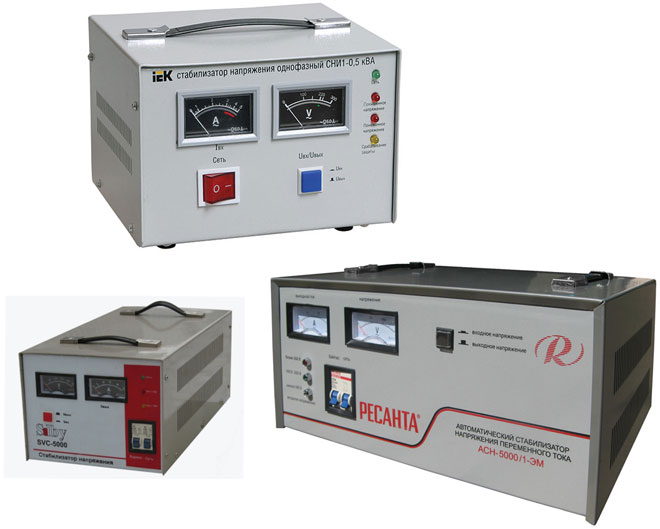
The main advantages are:
- low cost;
- small size;
- wide voltage adjustment range;
- smooth adjustment process;
- short-term overload resistance;
- high efficiency level.
Disadvantages:
- The unit operates noisily, especially noticeable at night;
- it does not respond instantly;
- There are moving parts that break more often than static parts;
- the need for regular maintenance;
- the possibility of operation at temperatures not lower than 5 degrees Celsius;
- susceptibility to dust ingress into the device.
Ferroresonant
The main feature of such transformers - the device uses the windings, which are put on the magnetic cores of different cross-section. Ferroresonant stabilizers are characterized by the accuracy of voltage regulation.
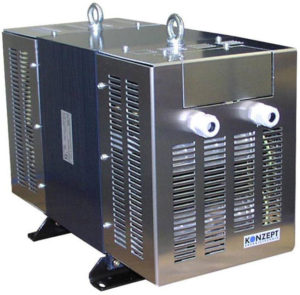
Let's name the advantages of such types:
- high reliability, which is due to the absence of switching circuits;
- long-term service;
- ability to work in conditions of high humidity and temperature fluctuations;
- high leveling accuracy;
- resistance to overloads.
Let's list the disadvantages of ferroresonant devices:
- high noise level during operation;
- large size and heavy weight;
- inability to function under significant overloads;
- dependence of the quality of operation on the magnitude of the load;
- formation of electromagnetic interference.
Inverter (stepless, transformerless, IGBT, PWM)
This type of regulator is considered one of the most expensive, but at the same time reliable. Therefore it is used not only at home but also in large-scale production. The mechanism of action of the inverter stabilizer is as follows: alternating current is converted into direct current and vice versa. This is due to the presence in the device of a microcontroller and a quartz oscillator. There are several types of devices on the market with different types of current conversion. The most common are PWM devices and transformers with IGBT transistors.
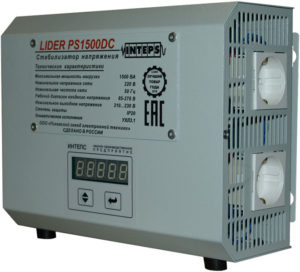
The advantages of the equipment are:
- fast response to voltage surges, as well as regulation accuracy;
- convenient device parameters due to the absence of automatic transformer;
- Efficiency reaches 90%;
- Ability to work at idle speed;
- effective suppression of surges and impulse noise;
- operation of the equipment at minus temperatures;
- noiseless operation;
- high accuracy of voltage regulation.
Disadvantages of the device:
- the quality of work deteriorates with overloads;
- high cost of equipment;
- complexity of the circuit, which complicates repair work;
- As the load increases, the range of input volts decreases.
Single-phase and three-phase
Voltage stabilizers are single-phase and three-phase. If you need to choose a device for apartments and houses, where single-phase network is most often laid, then buy Transformer with a voltage of 220 V.
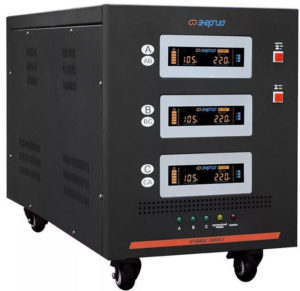
If you have a three-phase network, then you can install both single-phase and three-phase equipment. It all depends on financial possibilities and installation conditions. Experts say that it is more rational to put three single-phase stabilizers.
This is explained by the fact that in the situation when at least one phase goes out, the entire device will shut down until power is restored to all phases. Similar problems will not occur when installing three single-phase devices. The only disadvantage of this choice is the space required.
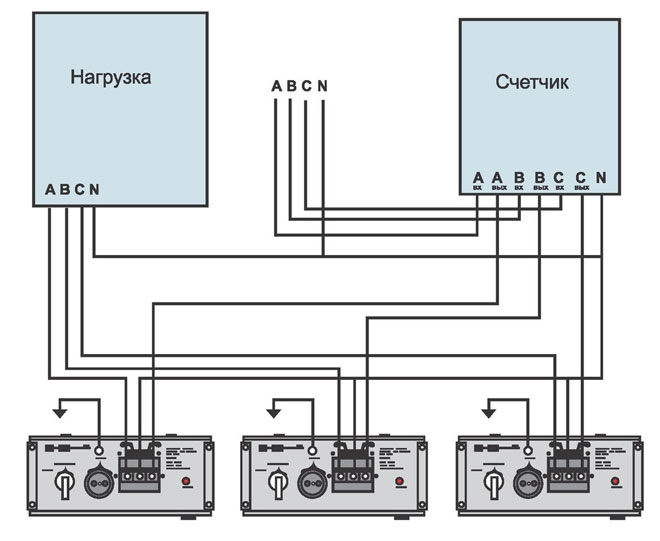
Also an argument in favor of installing three single-phase stabilizers is the fact that the load on the lines is distributed unevenly.
When choosing any stabilizer it is important to study its characteristics, one of which is the value of power consumption. The value depends on the number and power of electrical appliances that are constantly included in the network.
Conclusion
In this article we reviewed the main types of voltage regulators. It is worth noting that their choice depends on several factors: functional characteristics, cost and purpose of the device. You should not save on the purchase, because the device protects all existing equipment from breakdowns due to power surges.
Related articles:
